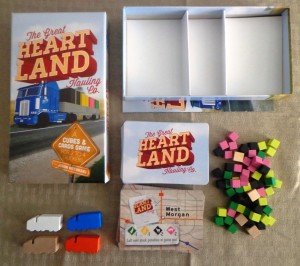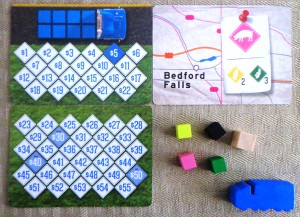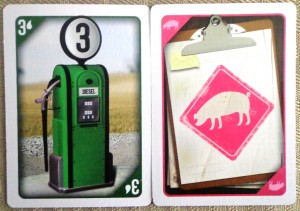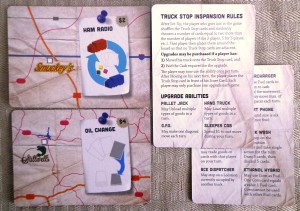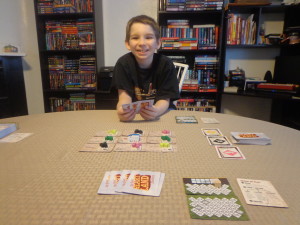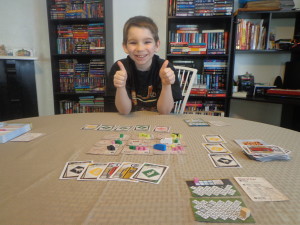If “Euro Truck Simulator 2” has taught me anything, it’s that you shouldn’t take bends at fifty-five miles per hours while hauling a vat of toxic substances. Luckily, “The Great Heartland Hauling Company” doesn’t test my competence as a truck driver…rather, players will be picking up and selling cargo as they move around the board. It’s a buy low, sell high kind of deal (sort of) while managing an inventory of cards and cargo. Before we take a look at this game in closer detail, I’d like to thank Dan Yarrington from Game Salute for providing me with a free review copy.
Editor’s Note: I received the “Badlands” expansion as well, the components of which I used during my play session. For more information regarding the expansion, please check out the link I provided at the end of this article.
Components
Location Cards – These cards are double-sided and serve as the main playing board. Each one lists goods that are native to the location (top) while also listing what is in demand (bottom). In the case of the latter, prices are listed next to each good. There is one distribution center card, which makes up the center of the playing grid during game setup.
Player Boards – There are a total of four card-sized player boards that help players keep track of their individual cash flow and any goods that they are currently hauling. Scoring cubes are used to assist players with keeping track of their cash.
Trucks – Each player will receive a truck, which they’ll use to travel around the board (location cards) so that they can perform actions.
Cards – The main deck is broken up into freight bill cards and fuel cards. The former allows players to pick up and sell goods while the latter allows a player’s truck to move around the board without spending cash. More on that in a bit.
Cargo Cubes – These wooden cubes come in different colors, representing the different goods available in the game. Players will be collecting these cubes from various locations and selling them elsewhere for cash.
Reference cards – Each player will receive one of these to assist them during gameplay.
The Truck Stop Inspansion – This upgrade to the base game was included after a Kickstarter stretch goal was met. It includes twelve location cards that allow players to purchase upgrades. Using this free expansion / variant pack is completely optional.
Setup
*The location cards are shuffled and arranged on the table randomly in a specific pattern, depending on how many people are playing the game. The distribution center card is placed in the center of the arrangement. It’s important to note that some location cards may be removed from this random draw deck beforehand, again, depending on how many people are playing.
*If you’re using the truck stop inspansion variant, players will randomly choose a number of cards (varies based on the number of players) and place them around the board.
*All of the location cards (except for the distribution center card) is seeded with five cargo cubes of its native good. The native good is the good listed on top of the chart shown on the location card.
*The fuel and freight bill cards are shuffled together to form a draw pile. Three cards are drawn face up next to the deck to form a separate draw pool that players can utilize, similar to that of “Ticket to Ride”.
*Each player receives a truck, player board, and five cards face down. They also receive a scoring cube, which they’ll place on the “5” on their respective player boards.
*The starting player is the person with the best mustache or longest hair…with ties going to the victor of an arm wrestling match.
Gameplay
On a player’s turn, they’ll observe the following phases:
1) Move your Truck – A player can either play fuel cards or spend cash to move (not both) at a ratio of 1 cash/fuel : 1 space, horizontally and/or vertically. In either case, a player can not move more than three spaces…that is, spend more than three cash or play cards that total over three fuel. Cash spent is deducted from a player board by moving the scoring cube appropriately. Players can never end their turn on the distribution center card, nor on a space containing another truck. Player also MUST move if possible, and can’t backtrack during their turn.
2) Take an Action – The player can perform one of three possible actions:
A) Load – A player can discard freight bill cards from their hand of one type to load the goods of the same type onto their truck. The number of cards they need to discard for one good depends on whether or not they are loading the location’s native good. A player can load goods onto their truck (on the player board) at a ratio of 1 card : 1 native good or 2 cards : 1 other good. A location’s native good is listed on the top of the chart shown at that location.
B) Unload – A player can discard freight bill cards from their hand of one type to unload the goods of the same type onto their current location. A player can unload goods at a ratio of 1 card : 1 good. After doing so, the player earns cash per good, at the rate listed on the bottom of the chart shown at that location. It’s important to note that locations can’t have more than eight goods stationed there.
C) Discard – A player can discard as many cards as they’d like from their hand at the cost of one cash.
3) Refuel – Players can take cards from either the draw deck or from the three cards shown next to it, up to the standard hand limit of five cards. Players replenish the resource pool after each individual draw, rather than wait until the end of their turn.
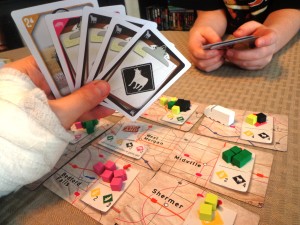
Cattle was profitable in my area, so I concentrated on collecting black freight bill cards whenever I could.
The game ends when a player reaches the cash goal limit on their player board, which varies depending on how many people are playing. The other players take one final turn and scores are adjusted, based on what cargo is stuck on a truck when the game ends. The person with the most cash after the adjustments are made, wins.
The above is simply an overview of the game and doesn’t cover all of the rules found in the manual, but should give you an idea of what the game is like. For more information, you can view the manual and a helpful tutorial video via the official website link at the end of this article. I included a link below to the manual as well, for your convenience.
http://dicehatemegames.com/wp-content/uploads/2012/07/HeartlandRulesProof731.pdf
The Review
Like “Carnival” (another Dice Hate Me game), the components were very colorful and sturdy. I had no problem reading the text on the cards, though I would have prefered the scoring and location cards to be bigger in general. The manual and tutorial video found on the official page were extremely helpful in summarizing the game, so players should definitely check out the latter if they are struggling with the former. Personally, I had no trouble understanding the rules after reading the manual / watching the video once. All in all, no problems in the components department.
The overall goal of the game is extremely simple: earn as much money as you can as quick as you can. How you go about doing that is where the strategy comes into play. The game will challenge you to think every turn and to be as efficient as possible. Wasting moves will drain your cash, which will eventually hurt your chances in the long run. Sure, the chances of you getting at least one gas card via the draw or resource pool is good, but you may find yourself choosing between using your one gas card to move one space or spending three cash to move three spaces. The “either or” mechanic is a good one, especially since every situation will be different. Players will also have to take into account their current cash versus that of their opponent when deciding on whether or not to use fuel or cash to move.
I like the fact that variants exist at the end of the manual, only solidifying the fact that the game is easily moddable to suit your group’s needs. Some variants include having less cargo space on trucks, mixing up goods and locations during setup (including the distribution center), and even address things like weight stations and closed roads. I indicated above that location cards are double-sided, making these variants optional but easy to introduce. I’m sure creative minds out there will be developing other variants…I myself have been toying with the idea of locations spawning / producing their native goods.
On that same note, the truck stop inspansion cards that came with the game as part of a Kickstarter stretch goal reward really added to the game’s depth. While the rules say to randomly place them around the board at start-up, a group could customize their game setup and agree on certain ones to enhance their gameplay experience. These upgrades alter the normal rules in various ways. For example, the smart phone allows a player to have a six card hand limit instead of five. The GPS allows you to move diagonally one time each turn, to name another example. All of these upgrades are great additions to the base game, though I’d recommend getting a few games under your belt first before adding them.
Overall, “The Great Heartland Hauling Company” is a fun game that has the right mix of resource management and economic functionality. It’s got just enough complexity to draw in the adult crowd while being simple enough to appeal to kids of most ages. Vinnie (11) liked it and didn’t have any issues understanding how the game mechanics worked. While some of the cards were too small for my liking, it allows the box to be portable enough to take almost anywhere. The price tag is a fair one, clocking in at around twenty bucks. It turned out to be a great family game, one that I’m glad I was able to add to my collection.
Final Verdict: 9/10
—
You can check out my review of the expansion pack, here:
http://www.dadsgamingaddiction.com/the-great-heartland-hauling-company-badlands-expansion/
You can learn more about and purchase “The Great Heartland Hauling Company” by visiting the following websites:
http://dicehatemegames.com/games/the-great-heartland-hauling-co/
http://shop.gamesalute.com/products/the-great-heartland-hauling-co
—

